Draft Sectoral Marine Plans for Offshore Renewable Energy in Scottish Waters: Consultation Paper
The Draft Sectoral Marine Plans for Offshore Wind, Wave and Tidal energy in Scottish Waters represent Scottish Ministers' proposed spatial policy for the development of commercial scale offshore renewable energy at a national and regional level.
B. DRAFT PLANS for Wave Energy in SCOTTISH WATERS
The Draft Plan for Wave Energy contains the potential options for future commercial scale wave developments (over 30 MW) in Scottish Waters. The Plan contains the following sections:
- Development of Draft Plan Options for Wave Energy
- National Issues
- Regional issues
Development of Options
B.1.1 In July 2012, Marine Scotland Science published 'A Scoping Report for Wave Farm Developments in Scottish Waters'. This document contained 4 large 'Scoping Areas of Search' which were considered in relation to 6 geographic locations. These areas, along with an explanation of the process to develop the Draft Plan, were then contained within the Draft Initial Plan Framework.
B.1.2 A period of pre-statutory consultation was undertaken, following publication of the Public Participation Statement, to raise awareness of the process for developing the Plan and highlight how the public can get involved. The Draft IPFs and RLGs were made available for comment to allow stakeholders the opportunity to present any further and more up-to-date information they may hold in relation to the Areas of Search.
B.1.3 The views and opinions gathered during the pre-statutory consultation, in addition to the information contained within the Draft RLGs were used to inform the revision of Areas of Search into Draft Plan Options.
Table 4. Evolution of Draft Plan Options - Wave
| Document |
Scoping Report for Wave Developments |
Draft Sectoral Marine Plan for Wave Energy |
|
|---|---|---|---|
| Region |
Scoping Area of Search / Location |
Draft Plan Option |
Location |
| NORTH |
North West of Cape Wrath |
- |
|
| North Sutherland Coast |
WN1 |
North Sutherland Coast |
|
| Orkney and Shetland |
WN2 |
North and West of Orkney |
|
| WN3 |
South West of Shetland |
||
| NORTH WEST |
West Hebrides (West of Lewis) |
WNW1 |
West Hebrides (West of Lewis) |
| WEST |
West of Hebrides (Mull and Islay) |
WW1 |
North West of Islay |
| WW2 |
South West of Mull |
||
| West Hebrides (West of Lewis) |
WW3 |
South West of Tiree |
|
| WW4 |
South West of Barra |
||
Fig.10 Wave Scoping Areas of Search ( BEFORE)
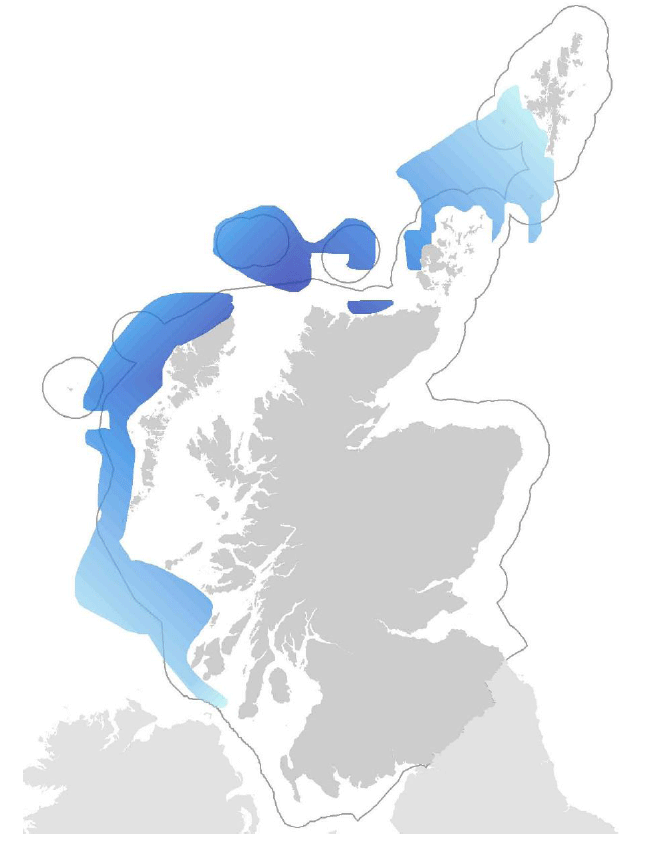
Fig.11 Wave Draft Plan Options ( AFTER)
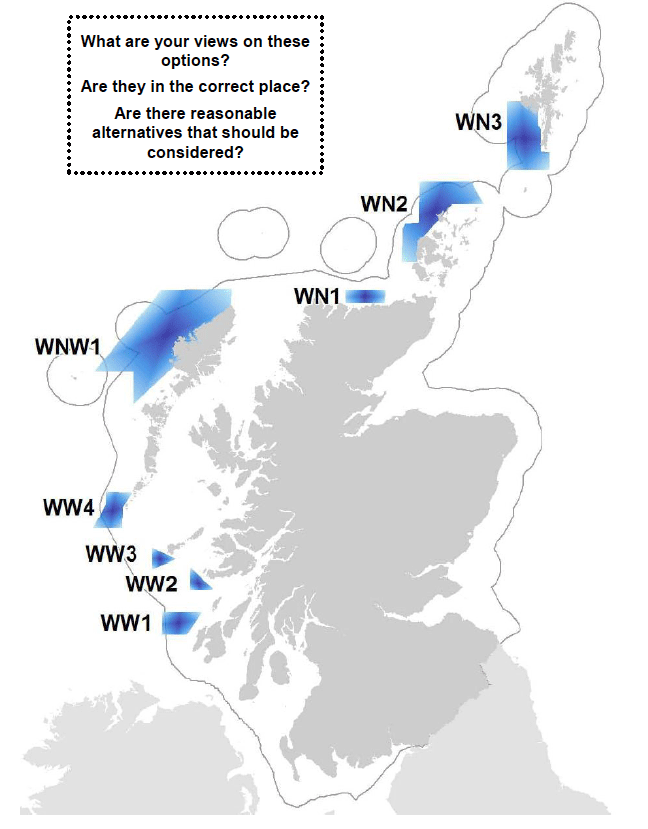
SEARCH NMPi - ' SMP - Wave Draft Plan options'
B.1.4 The Draft Plan Options represent development zones in which a proportion could ultimately be used for development. The Plan seeks to identify issues for consideration at project level zone planning and project licensing.
B.1.5 In addition to the draft Plans Options emerging from the Scoping 'Areas of Search, the process to develop the Draft Plan for Wave Energy also gave consideration to the need to incorporate options arising from the following processes:
- PFOW and the Saltire Prize Locational Guidance
- Further Locational Guidance produced by the Scottish Government.
- Developments which have an award of 'agreement for lease' from the Crown Estate Commissioners and are therefore at the licensing stage.
- These options are underpinned by the 2007 Marine Renewables SEA.
- A full lease will only be awarded once a developer has obtained a marine licence from the Scottish Government
B.1.6 There were no additional 'existing options' to be considered within this sectoral marine planning process as:
- Options within Saltire Prize Locational Guidance would still be used for innovative test and demonstration developments in support of the Saltire Prize and not commercial scale developments
- Options arising from Crown Estate Pentland Firth and Orkney Waters leasing and further rounds are either:
- Underpinned by the 2007 Marine Renewables SEA where developments exceed the 30 MW threshold
- Do not exceed the 30 MW threshold to be classified as a commercial scale development
B.1.7 In draft Wave Plan Options where the straight zone boundary lines runs alongside the coastline, the boundary line has been amended to reflect the potential for surf zone wave energy technologies. This slight alteration is consistent with the approaches to and outcomes of the Sustainability Appraisal.
National Issues
B.2.1 The draft Plan Options for Wave Energy have been subject to Strategic Environmental Assessment ( SEA), Habitats Regulations Appraisal ( HRA) and socio-economic assessment. The outcomes of these assessments have been brought together within the Sustainability Appraisal Report. The sections below contain the key issues arising at a national level from these assessments:
Sustainability Appraisal
Strategic Environmental Assessment
B.2.2 The SEA Environmental Report provides the detail on the identification and assessment of potential effects of the Draft Plan Options for wave energy. The key results are summarised below:
- Potential effects on biodiversity as a result of collision with devices, particularly those with underwater components, barriers to movement of mobile species. Noise impacts on sensitive species from the construction of devices. The SEA considers potential effects on diving birds, cetaceans, seals, elasmobranchs and fish species. Additionally there may be direct loss of seabed habitat from the installation of devices and effects associated with potential changes to patterns of tidal and sediment movement on marine habitats.
- Scope for impacts on water quality from contamination as a result of changes to turbidity and turbulence, and seabed disturbance in areas of existing contamination. The significance of effects will depend on the proximity of devices to sensitive areas, such as those for fish spawning and feeding and shellfish growing waters.
- Positive effects for climate change mitigation through moving to decarbonisation of energy supply.
- Changes to turbidity, sediment disturbance, and loss of geology in placing devices may have secondary impacts on coastal processes. The significance of effects will depend on the proximity of devices to more sensitive coastlines such as those with geological SSSI and Geological Conservation Review sites ( GCRs).
- Potential direct effects on submerged archaeology during construction and in some cases, particularly those devices that sit above the water surface potential for effects on the setting of features of the historic environment.
- Potential for visual impacts on landscape and seascape character as a result of the presence of surface-piercing structures, and potentially marker buoys and lights for navigation, particularly if located near-shore and in large numbers. Submerged and oscillating devices may have fewer impacts than devices which sit on top of the water, but this will depend on location and the quality of the receiving environment. The magnitude of visual effects depends in general on visibility and positioning of devices in regards to onshore features. Visual effects for other sea users, such as recreation vessels, may increase if constructed in popular recreational locations. Effects from lighting at night time are possible and potentially of greater significance for near shore areas.
- In some locations new structures could increase collision risk for some vessels, particularly for small vessels in conditions where waves might make it difficult to locate devices from a distance. Collision risk may increase if channels of vessel movements are reduced due to potential exclusion zones. The likelihood of effects are considered to be of lower significance and able to be mitigated. Furthermore there may be some potential for displacement of recreational activity in some near shore locations.
In all cases the SEA cannot provide precise certainty of effects as opportunities to mitigate and minimise effects are available as projects are planned, primarily through project design and location within Draft Plan Options. The significance of some of the potential effects can also only be established at the project design stage.
Draft Habitats Regulations Appraisal
B.2.3 The ongoing HRA of the draft wave plan options continues to consider likely significant effects on the integrity of European designated sites. The HRA has confirmed the potential for the effects identified in the SEA. The HRA will focus on the following potential impact pathways:
- Direct and indirect physical damage to the habitats including consideration of the potential sensitivity of habitats (reefs, sub-tidal sandbanks, intertidal habitats including saltmarshes, and supralittoral habitats) during the construction, operation and decommissioning phase. Furthermore the potential for structures on the seabed to act as Fish Aggregating Device ( FAD) are considerations. The HRA will also include some consideration of physical damage from cabling on onshore habitats.
- Physical damage to species due to collision risk including Bottlenose dolphins and Harbour porpoise, Grey and Harbour seals, Atlantic salmon, Lamprey, Shad, seabirds and diving birds. The appraisal indicates further work at the project level will be required.
- Barrier effects during operation for species including Bottlenose dolphins, Harbour porpoise, Grey and Harbour seals, Atlantic salmon, Lamprey and Shad.
- Visual disturbance to surface feeding and diving birds.
- Noise and vibration effects during construction and decommissioning for species including Bottlenose dolphins, Harbour porpoise, Grey and Harbour seals, Atlantic salmon, Lamprey and Shad.
- EMF effects, although sensitivity is considered to be low, for Bottlenose dolphins, Harbour porpoise, Grey and Harbour seals, Atlantic salmon, Lamprey and Shad.
- Contamination resulting from elevated turbidity
Socio-economic Assessment
B.2.4 Table 5 demonstrates the quantified economic impacts of draft plan options for wave energy on other marine activities at a national level. The majority of impacts fall upon the Commercial Fishing industry, although these remain relatively minor. In addition to the above, there are a number of non-quantified impacts and social impacts.
Table 5: Present value ( PV) costs for Wave Energy at a national level, £m (costs discounted over assessment period, 2012 prices, values rounded to nearest £0.01m)
| Activity |
Description of Measurement |
Scenarios |
||
|---|---|---|---|---|
| Low |
Central |
High |
||
| Commercial Fisheries |
Value of potentially lost GVA (derived from landed values) |
0.07 |
0.18 |
0.38 |
| Water sports - Sea Angling |
Reduction in expenditure |
0.00 |
0.00 |
0.10 |
| Total PV costs |
0.07 |
0.18 |
0.48 |
|
B.2.5 The remainder of the Plan contains a breakdown of the key issues in relation to the plan options within the following regions:
- North
- North West
- West
Table 6. Draft Plan Options for Wave Energy by Region
| DRAFT PLAN OPTIONS |
|
|---|---|
| REGION |
WAVE (W) |
| NORTH |
WN1 |
| WN2 |
|
| WN3 |
|
| NORTH WEST |
WNW1 |
| WEST |
WW1 |
| WW2 |
|
| WW3 |
|
| WW4 |
|
*There are no potential wave plan options within the East, North East and South West Regions
B.2.6 Illustrative maps within each Region contain the following developments where applicable:
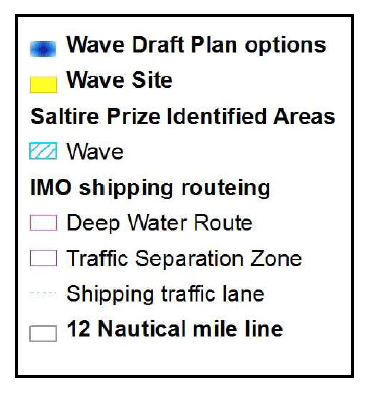
B.2.7 The key issues emerging from the Sustainability Appraisal listed in relation to each region. Further explanation is provided within the Sustainability Appraisal Report with a full breakdown of the issues contained within the respective socio-economic and environment assessments.
B.2.8 The consideration of cumulative and in-combination effects arising from existing, planned and potential future development options is considered within Section D.
B.3 North
B.3.1 The North Region contains the following potential future options:
- WN1
- WN2
- WN3
Fig.12 Draft Plan Options for Wave Energy - North
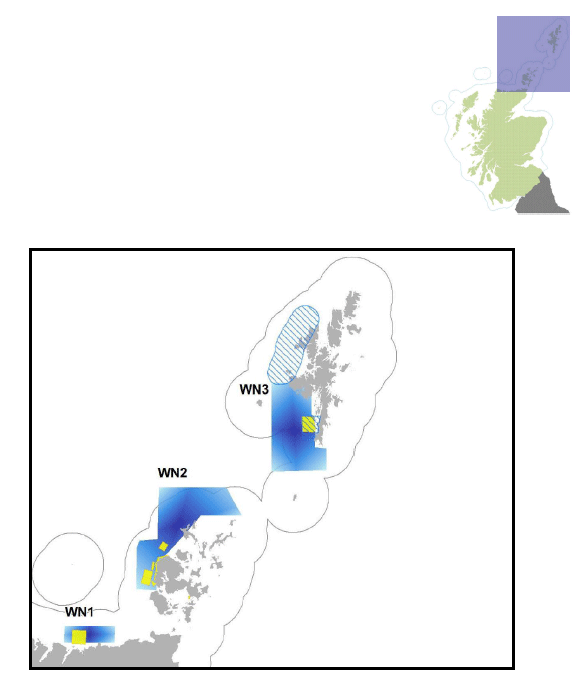
B.3.2 The Sustainability Appraisal indicates the following issues to be of particular significance in this region:
- Biodiversity
- Cultural Heritage
- Recreation
- Social impacts
- Community engagement
- Landscape and seascape (including designations)
- Seabed and coastal processes
B.4 North West
B.4.1 The North West Region contains the following potential future options:
- WNW1
Fig.13 Draft Plan Options for Wave Energy - North West
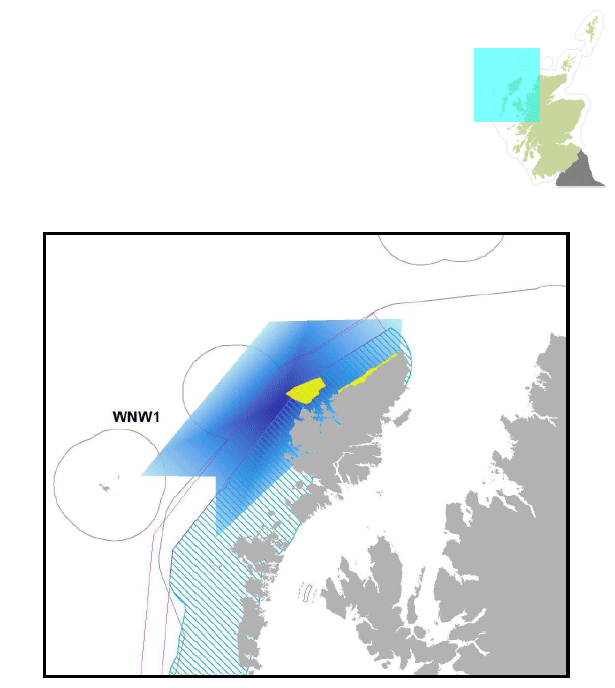
B.4.2 The Sustainability Appraisal indicates the following issues to be of particular significance in this region:
- Biodiversity
- Recreation
- Community engagement
- Grid
- Landscape and seascapes (including designations)
- Cultural Heritage
B.5 West
B.5.1 The West Region contains the following potential future options:
- WW1
- WW2
- WW3
- WW4
Fig.14 Draft Plan Options for Wave Energy - West
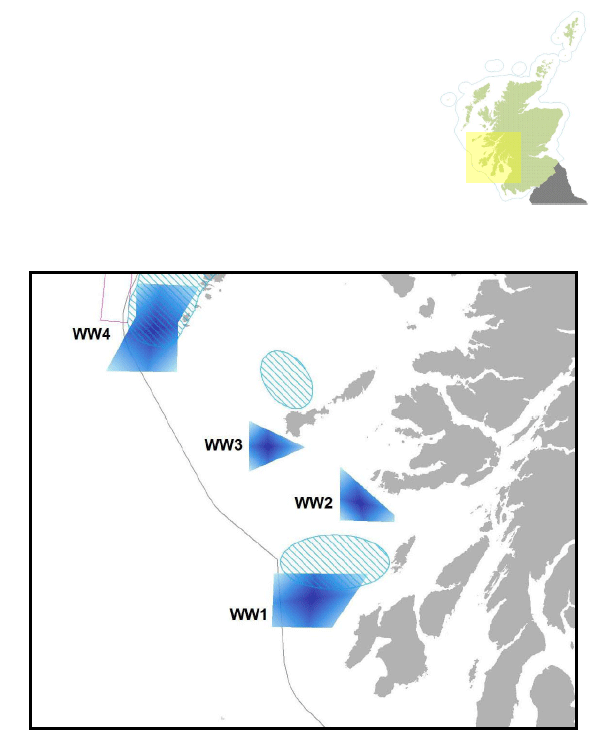
B.5.2 The Sustainability Appraisal indicates the following issues to be of particular significance in this region:
- Communities
- Biodiversity
- Recreation
- Landscapes and Seascapes (including designations)
- Cultural Heritage
- Grid
- Seabed and coastal process
Contact
There is a problem
Thanks for your feedback